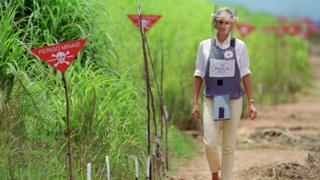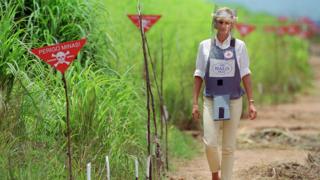Prince Harry in southern Africa: Where are the world’s landmines?
Prince Harry will highlight the fact that landmines continue to take thousands of lives. …

 Image copyright Getty Images
Image copyright Getty Images In 1997, Princess Diana walked through a field scattered with deadly landmines in Angola. The images became world famous.
As part of his tour of southern Africa, the Duke of Sussex will visit the country to highlight continuing efforts to remove and destroy them.
Landmines continue to take thousands of lives in dozens of countries. So where in the world are they and what progress has been made?
Why did Princess Diana visit Angola in 1997?
The princess was known for her charity work, championing causes which weren’t always in the public eye. She had previously opened the UK’s first HIV/Aids clinic in 1987, for example. That helped to change attitudes to the virus.
Raising awareness of landmines was the princess’s first major cause after divorcing the Prince of Wales in 1996.
For decades landmines had been widely used in conflict.
Many unexploded devices left over from wars were killing and maiming people who stepped or triggered the bombs unintentionally.
Images of her with amputees in Angola showed the destruction the devices were causing.
During his trip, Prince Harry will learn about demining efforts, looking to build on the legacy started by his mother.
What are landmines and how many people do they kill and injure?
Landmines are explosives. They have detonating systems that are triggered by contact and are usually buried just under the ground, or above it.
There are two main types: anti-personnel landmines, aimed at killing or injuring a person, and anti-tank mines, designed to destroy or incapacitate vehicles.
Mines were used in World War One, but their deployment proliferated from the 1960s onwards.
Countries with highest number of casualties from mines in 2017
The random placement of mines became part of military strategy, creating hazardous environments for many people. About 60 countries and territories are still contaminated with anti-personnel mines.
More than 120,000 people were killed or injured by landmines between 1999-2017, according to research by Landmine Monitor.
Nearly half of the victims are children, with 84% being boys. Civilians make up 87% of casualties.
Which countries have the most landmines?
Around the world, thousands of landmines remain.
Angola is one of the most mined places in the world, because of the civil war there from 1975 to 2002.
The demining charity Halo says it is impossible to know exactly how many mines are in the country, but it has decommissioned almost 100,000 since 1994.
The Angolan mine authority says there are approximately 1,200 minefields.
Removing mines is a costly and dangerous task. At current rates, it would be likely to take hundreds of years to eradicate them completely around the world.
Other territories with large areas covered in mines are Chad, Afghanistan, Cambodia, Thailand, Azerbaijan, Bosnia-Herzegovina, Croatia, Turkey, Iraq, Yemen and Western Sahara.

Media playback is unsupported on your device
What is being done to prevent landmines killing more people?
Princess Diana’s involvement in the anti-mine cause involved a call for a global ban on mines.
In 1997, just three months after her death, 122 countries signed the Ottawa Treaty, that prohibits the use, production, stockpiling and transfer of anti-personnel mines.
Countries are also obliged to clear minefields within 10 years of signing up and to destroy stockpiles within four years.
There are now 164 countries bound by it – including the UK. However, the US, China, India and Russia – which is thought to have the largest stockpile – are among the 32 United Nations members that have not signed it.
Clearance of anti-personnel mines around the world
Most states have not met their deadlines and mines are still being planted.
The continuing use of anti-personnel mines has been reported in Myanmar (formerly known as Burma), which has not signed up to the treaty.
Non-government forces also use them, such as militants Boko Haram which have been placing improvised landmines in north-eastern Nigeria since 2014.




